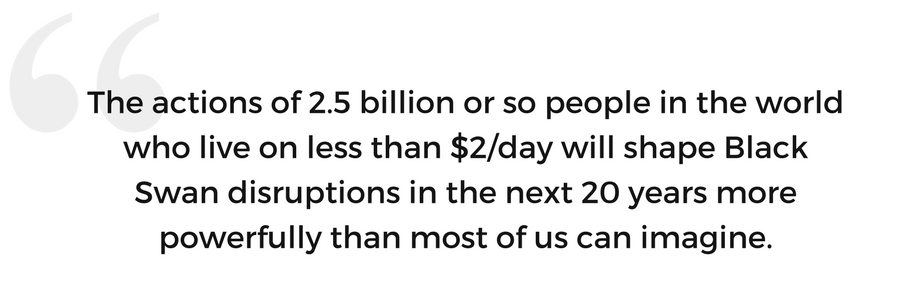Energy experts now confidently predict that by 2040, solar and wind will drive no less than 60 percent of global power; natural gas will replace the lion’s share of the burning of coal, and the market for electric cars will soar.
Nassim Taleb, on the other hand, questions the ability of experts to predict just about anything. He asserts instead, in The Black Swan: The Impact of the Highly Improbable, that the future is consistently shaped by unexpected, high-impact outlier events, which we do our best to rationalize after the fact. Who could have predicted the Black Swan disruptive transformative impact of Henry Ford’s Model T, or Jobs and Wozniak’s Apple?
As a faithful Black Swan convert, I doubt our ability to predict our planet’s energy future in 2040. We can, however, make educated guesses about the forces likely to give shape to the energy Black Swans in our immediate future. Here is one of them.
By 2040, solar and wind will drive no less than 60 percent of global power. Tweet This Quote
The actions of 2.5 billion or so people in the world who live on less than $2/day will shape Black Swan disruptions in the next 20 years more powerfully than most of us can imagine. They are already responsible for just about all of the planet’s population growth in the next two decades, which will profoundly affect environmental balance. That’s why the current omission of this population’s actions in predictions of our energy future is astounding.
These shapers of our energy future are disproportionately distributed in poor rural areas in close proximity to strands of high energy invasive biomass, which can most easily be converted into low carbon emitting alternatives to coal. This carbon substitute will create millions of new jobs and massive new markets for village-produced energy products, helping these communities move out of poverty in the process. A perfect example of this kind of prevalent biomass is mesquite, found predominately in arid lands.
 Nature takes 300 million years to produce coal. But through a process called torrefaction, which is exactly the same as roasting coffee, a group of volunteer engineers at Ball Aerospace have reduced the time to one hour, producing a blackened biomass – from mesquite and others – that looks like coal, burns like coal and best of all mimics nature’s carbon cycle instead of increasing carbon emissions.
Nature takes 300 million years to produce coal. But through a process called torrefaction, which is exactly the same as roasting coffee, a group of volunteer engineers at Ball Aerospace have reduced the time to one hour, producing a blackened biomass – from mesquite and others – that looks like coal, burns like coal and best of all mimics nature’s carbon cycle instead of increasing carbon emissions.
The future is consistently shaped by unexpected, high-impact outlier events. Tweet This Quote
Using selected agricultural waste streams and invasive species that grow in arid wastelands as inputs, it is now possible for us to design 100,000 village kilns, each capable of producing seven tons a day of a low carbon emitting substitute for coal. The shortening of the collection radius from 150 kilometers to 4 kilometers, taking advantage of low-cost labor in rural villages, and adding carbon credits to the mix is now likely to produce a new breed of multinational corporations. These new MNCs will partner with village enterprises and will be capable of replacing up to 20 percent of global carbon emissions. Best of all, if it works, it will become a profitable international corporation, supported by investment capital instead of the begging bowl.
This is my dream for the future. Whether it will turn out to be a dream or a nightmare remains to be seen.
This article was co-authored by Krish Desai.



